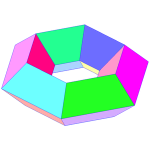Universal coverings of simplicial groups
Tuesday, July 03rd, 2012 | Author: Konrad Voelkel
Every simplicial set admits a universal covering space. If the simplicial set is a simplicial group, the covering can be given a group structure, such that the covering map is a group homomorphism. This can be done "at once" without using geometric realizations, just by close analysis of the usual construction of the universal covering.
Let  be a simplicial group,
be a simplicial group,  its path space,
its path space,  its loop space and
its loop space and  the kernel of the projection
the kernel of the projection  , which consists of all contractible loops. The composition of
, which consists of all contractible loops. The composition of  with the inclusion
with the inclusion  yields a monomorphism
yields a monomorphism  whose cokernel we denote by
whose cokernel we denote by  .
.
I claim that this simplicial group already does the job.
To see this, we stare at the following commutative diagram

with exact rows by construction.
The left hand column is trivially exact, the middle column is exact by definition of the loop space, and by a diagram chase (special case of the 9-lemma) we get exactness of the right hand column. So we have proved that the fibration  with discrete fiber has kernel
with discrete fiber has kernel  . The corresponding fiber sequence yields in the lower terms an exact sequence
. The corresponding fiber sequence yields in the lower terms an exact sequence

where the middle arrow
 is an isomorphism, so we know that
is an isomorphism, so we know that  and
and  are trivial.
are trivial.From the same fiber sequence we obtain that for all
 there is an isomorphism
there is an isomorphism  .
.
I do not claim this proof to be new (it is way too simple), but I haven't found it in the literature and it might help understanding how the tools involved work, so this is expository work. For the notation and objects used, you can consider the book of Goerss and Jardine: Simplicial Homotopy Theory.
I do not like the proof via geometric realization, which roughly goes like that: Take a simplicial group, realize it to a topological group, construct the group structure on the fiber over the basepoint and on a neighbourhood around the basepoint, show that this is somehow compatible, take the singular resolution and see that this is a simplicial group covering something which is weakly equivalent to the original thing. I suspect most of my readers know how to prove that the universal covering of a Lie group is a Lie group again. The usual proof of this is similar to the argument done after geometric realization.
Someone remarked that the diagram above resembles the octahedral axiom. Can you make sense of this?

2017-04-09 (9. April 2017)
the square up-right should be a pushout?
2017-04-13 (13. April 2017)
you wrote "Every simplicial set admits a universal covering space."
Is it because of the fact that the geometric realizations of simplicial sets are semi-locally simply connected?
2017-04-13 (13. April 2017)
No, this has nothing to do (a priori) with geometric realization.
One way to get a universal covering is to use a path space as I did in this post.
There are many ways to kill the fundamental group without changing the higher homotopy. For example, you could also just manually glue in cells to kill generators for the fundamental group and then glue in more cells to kill the extra homotopy you introduced by this. Keep going and you'll end up with a model for the universal cover.